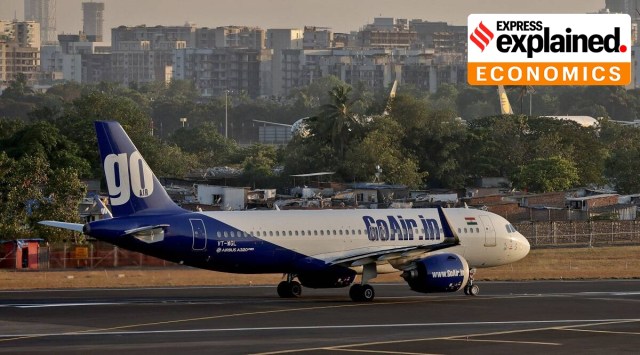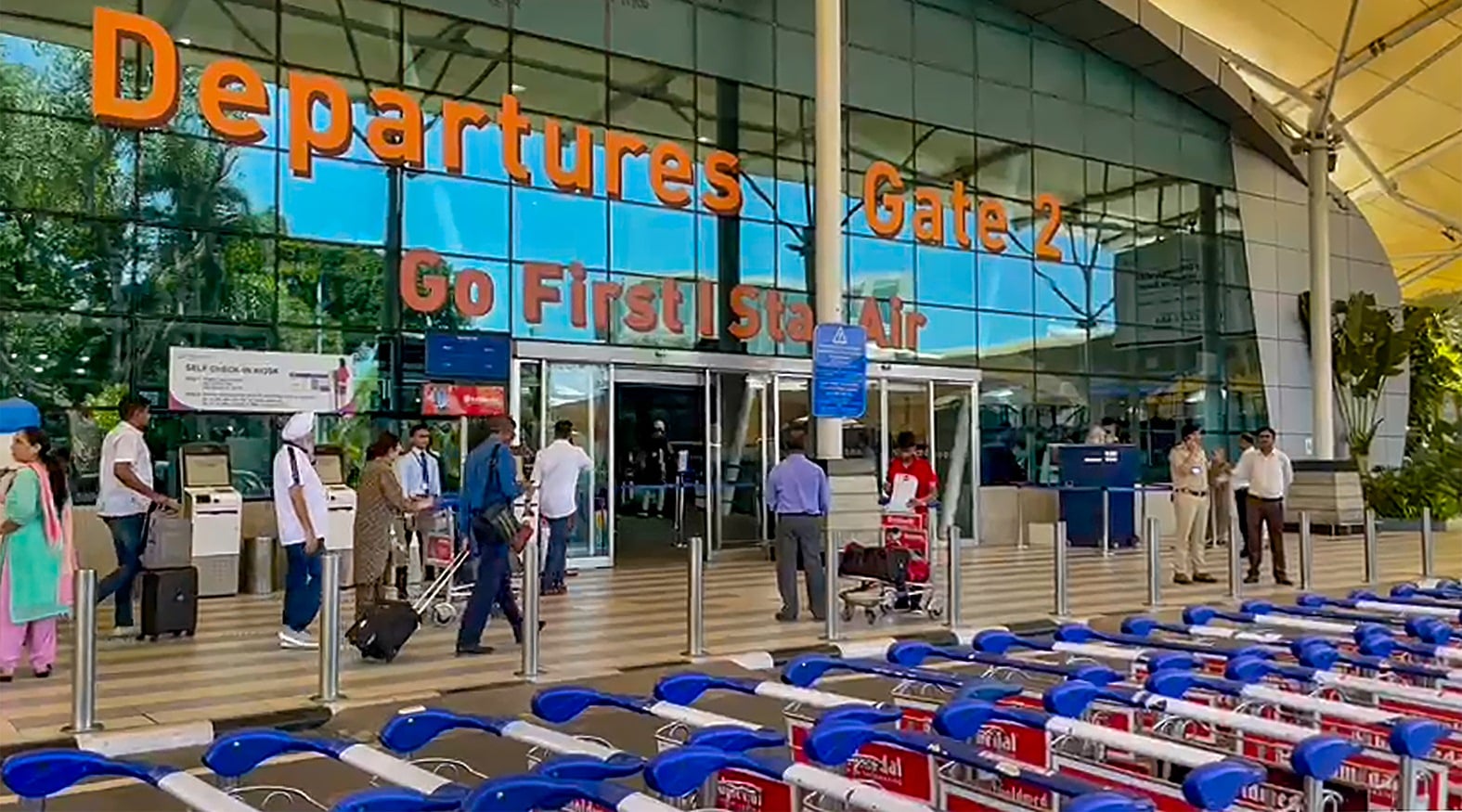Cash-strapped no-frills carrier Go Airlines (India) Ltd (Go First), said on Tuesday that it was filing for voluntary insolvency proceedings with the National Company Law Tribunal (NCLT), blaming engine manufacturer Pratt & Whitney (P&W) for its financial situation.
The Wadia Group airline has been struggling for some time now, with half its fleet of aircraft grounded due to snags in their P&W engines, and other financial problems.

However, its decision to go on its own to the NCLT, the adjudicating authority for insolvency resolution under the Insolvency and Bankruptcy Code (IBC), 2016, came as a shock for employees, passengers, and the sector.
Industry insiders believe this could spell the end of Go First (formerly GoAir) in its current avatar, a development with likely ramifications for India’s highly competitive aviation landscape.
Go First is the first Indian carrier since Jet Airways to go to the NCLT under the IBC. The tribunal will hear the airline’s plea on Thursday.
 At Mumbai airport on Wednesday. Go First has cancelled flights until May 5. (PTI)
At Mumbai airport on Wednesday. Go First has cancelled flights until May 5. (PTI)
What has Go First said?
The airline said it was “forced to apply to the NCLT” after “the ever-increasing number of failing engines supplied by Pratt & Whitney’s International Aero Engines” led to the grounding of 25 aircraft, or half its fleet of Airbus A320neo planes, and major financial stress.
Story continues below this ad
Go First said P&W — which is the exclusive supplier of engines for A320neos — had failed to meet contractual obligations and refused to comply with an arbitration award from the Singapore International Arbitration Centre (SIAC). It added that more likely engine failures over the next three-four months, would have made its operations “unviable”.
Go First has been hit by engine snags since January 2020. It has claimed that the percentage of its grounded aircraft due to P&W’s “faulty engines” had grown from 7% in December 2019 to 31% in December 2020, and to 50% in December 2022. This, while incurring 100% of operational costs, has set it back by Rs 10,800 crore in lost revenues and additional expenses, Go First has said.
According to the airline, SIAC had directed P&W to dispatch at least 10 serviceable spare leased engines by April 27, and 10 spare leased engines per month until December. Had P&W complied, the airline could have returned to full operations by August or September, leading to its “financial rehabilitation and survival”, Go First has said.
It has also claimed that following P&W’s actions, some lessors repossessed aircraft, drew down letters of credit, and notified further withdrawals of planes. “…These actions will result in a severe depletion in the number of aircraft…, thereby making it further unfeasible for Go First to continue its operation and meet its financial obligations,” the airline said.
Story continues below this ad
How has Pratt & Whitney responded?
Sources in the engine manufacturer denied Go First’s allegations, and said the airline has a “lengthy history of missing its financial obligations” to P&W. But P&W did not mention this in its brief official statement. It denied Go First’s allegation that it was not complying with SIAC’s directions.
“Pratt & Whitney is committed to the success of our airline customers… P&W is complying with the March 2023 arbitration ruling related to Go First. As this is now a matter of litigation, we will not comment further,” the statement said.
Go First has also filed an emergency petition in a US court seeking enforcement of the SIAC award.
Story continues below this ad
Which creditors have exposure to Go First, and how much?
Go First has told NCLT that it owes Rs 6,521 crore to financial creditors, Reuters has reported. While the carrier had not defaulted on its dues until April 30, it has informed the NCLT that given its current financial position, defaults are “imminent”.
It has already defaulted on payments to operational creditors, including Rs 1,202 crore to vendors and Rs 2,660 crore to aircraft lessors.
According to the Reuters report, the NCLT filing lists public sector lenders Central Bank of India, Bank of Baroda, and IDBI Bank, and private sector players Axis Bank and Deutsche Bank among Go First’s financial creditors. Central Bank of India and Bank of Baroda reportedly have an exposure of Rs 1,300 crore under a consortium loan, while IDBI Bank has an exposure of around Rs 50 crore.
Story continues below this ad
Go First had also borrowed Rs 1,292 crore under the government’s Emergency Credit Scheme. Its total liabilities to all creditors — including dues to banks, financial institutions, vendors, and aircraft lessors — are Rs 11,463 crore, Reuters reported, quoting the filing.
Operational creditors will likely be affected more by Go First’s bankruptcy than financial creditors. This is because financial creditors are accorded a higher priority than operational creditors under the IBC. Additionally, according to Sarin & Co, a law firm specialising in aviation-related matters, the admission of Go First’s application for insolvency resolution under Section 10 of the IBC would have “extreme ramifications for lessors and financiers who may have aircraft currently in the possession of the applicant”.
In a note, the law firm said: “Upon admission of an application for the corporate insolvency resolution process…a complete moratorium comes into play which prohibits ‘any action to foreclose, recover or enforce any security interest created by the corporate debtor in respect of its property’…and ‘the recovery of any property by an owner or lessor where such property is occupied by or in the possession of the corporate debtor’.”
Any lease agreements, etc. on the date of admission of the application may also be impacted by the moratorium, the note added.
What does this mean for Go First’s competitors?
Story continues below this ad
Although Go First was already operating a truncated fleet due to widespread groundings and was continuously bleeding market share, its absence from the skies could create an opportunity for other domestic carriers.
Go First has cancelled flights until May 5; it is also not taking new bookings until May 15. With the matter now with the NCLT, the disruption is expected to be prolonged.
Shares of InterGlobe Aviation (IndiGo) and SpiceJet rallied on Wednesday. Other Indian airlines are not listed on the stock exchanges.
In March, Go First’s domestic market share (by passengers carried) was 6.9%; for the Jan-Mar quarter, it was 7.8%, Directorate General of Civil Aviation (DGCA) data show. For Jan-Mar, Go First was the third largest domestic airline by market share. It carried almost 9 lakh fliers in March; more than 29 lakh in Jan-Mar.
Story continues below this ad
India’s overall domestic passenger count for March and Jan-Mar were 1.29 crore and 3.75 crore respectively. Go First had an impressive passenger load factor (PLF, or capacity utilisation) of more than 90% during Jan-Mar.
In this year’s approved summer schedule (Mar 26 to Oct 28) for Indian carriers, Go First was to operate 1,538 flights per week, 10.7% more than the preceding winter schedule.
If Go First does not return to the skies soon, its passenger load and market share will be up for grabs. Going by recent experience, other airlines may also look to bag Go First’s vacant slots at airports — in 2019, DGCA and the Civil Aviation Ministry had decided to redistribute slots left unutilised by Jet Airways, which were lapped up by competitors.
And how will passengers be impacted?
At a time when fares are already high due to resurgent air travel, Go First’s seats going off the market will likely raise them further, at least in the immediate-to-near term, industry experts said. This is because other carriers are already seeing high PLFs, and are unlikely to be able to immediately deploy additional capacity to completely fill the hole left by Go First.
Story continues below this ad
Simply put, demand is likely to rise for other airlines in sectors where Go First has been a strong player, while supply is likely to remain limited in the near future. While some additional capacity deployment and network adjustments by other carriers is expected almost immediately, these are unlikely to fully offset the impact of Go First’s absence.



 At Mumbai airport on Wednesday. Go First has cancelled flights until May 5. (PTI)
At Mumbai airport on Wednesday. Go First has cancelled flights until May 5. (PTI)




































